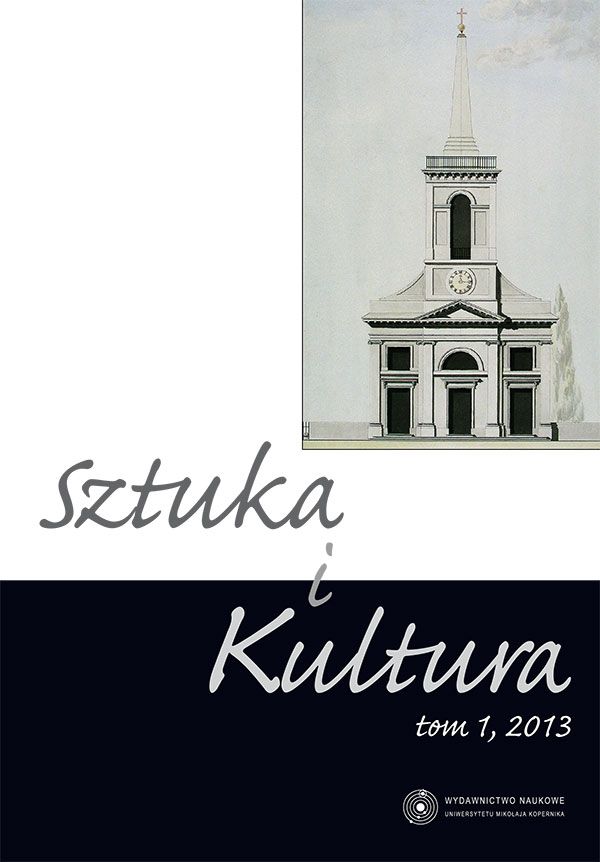The Paradigm of Style: French sculpture in Warsaw of 1935
DOI:
https://doi.org/10.12775/SZiK.2013.007Keywords
sculpture, neoclassicism, neorealism, neohumanism, NazismAbstract
The Paradigm of Style focuses on the notion of national tradition and on the idea of national identity perceived as intellectual constructs, which in Europe of the 1930s were supposed to serve non-artistic purposes – ideologization of aesthetics and political propaganda. The issue of an idiosyncratic national style that was freed from foreign influences and stigma, and expressed specific racial features and a ‘tribal temperament’ was also an important element of the critical and theoretical discourse of the period. The article refers to the diversified employment of these conceptual categories while analyzing the reception of the exhibition of French sculpture organized in 1935 under the auspices of the French government at the Institute of Art Propaganda in Warsaw – a venue of crucial importance to the cultural policy of the Polish state. Paul Jamot, Louis Hautecour, and Claude Roger-Marx had selected exhibits that were to exemplify the development of French sculpture over the past sixty years. Yet the choice proved to be overtly tendentious and ideologically biased since all strands of modernism and avant-gardism had been erased from the scenario. A hundred and one sculptures and forty-three drawings of thirty-three artists (including Auguste Rodin, emile Antoine Bourdelle, Aristide Maillol, Charles Despiau, Joseph Bernard) testified to the ambitious scope of this enterprise which was meant to enhance the nationalist propaganda goals disseminated in the country, where under the cover of democracy and neohumanism, the wave of xenophobia intensified, and traditionalist and regionalist slogans were to defy the cosmopolitan ethos of the Parisian artistic milieu. Apart from the catalogue entry penned by Hautecour, Paul Jamot and Pierre Francastel delivered lectures on the history of French art in order to emphasize the specificity of its evolution and its idiosyncratic features. Warsaw critics highly praised the presentation of French sculpture. Apart from numerous reviews of the exhibition, surveys of French sculpture, reaching as far back as the Middle Ages, were published in the periodicals. The Paradigm of Style articulates basic criteria of evaluation and the ways of classification which were referred to French modern sculpture in Polish art criticism of the 1930s. Furthermore, the narrative explores a questionnaire featured in a 1937 issue of the journal “Głos Plastykow” (“The Voice of Artists”) that had been carried out among Polish sculptors in order to elicit their opinions on contemporary native sculpture, and, what is noteworthy, also on French sculpture. Proponents of a wide range of artistic trends responded to it, from adherents to Neoclassicism and Neorealism, through exponents of different shades of syncretism, up to the leading figures of Constructivism. It thus seems intriguing to juxtapose the accounts provided by Polish and French authorities from the art world in an attempt to grasp at the cross-section of diverse axiological and historiographical perspectives, the semantic content of such categories as “the genius of the Latin race,” “the French spirit,” “national art,” and “native style” – the key notions of the 1930s’ reflection on art throughout Europe. The article shows, that Polish commentators perceived neoclassical French sculpture as a modern reinterpretation of the Greco-Roman antique and, simultaneously, as a reconsideration of the Gothic tradition. It appeared to be homogenous enough, in the opinion of some critics, to denote a style, though for others it embraced an array of individualized sculptural formulae. Writers, who reflected upon the inherently diversified trend of twentieth-century classicism, employed terminology that was partly borrowed from Heinrich Wollflin. Moreover, they tended to construct certain antinomies, anticipating in a way Derrida’s theoretical explorations. Therefore, the Neoclassical movement appeared to be at once anti-academic, anti-naturalistic, anti-impressionist, antiexpressionist and anti-modernist. French sculpture was also evoked as a model for domestic artists to learn how to cultivate indigenous elements in art while preserving universalizing ambitions. Hence, the key notions of the 1930s critical discourse reveal their semantic vagueness and sometimes questionable relevance to the morphological and expressive features of the art works being discussed, as well as their openness to ideological manipulation and instrumental treatment. The discussed key-words connoted the slogans of nationalist ideology that was developing in France and Poland of the 1930s. They did not enable, however, precise morphological descriptions, analytic interpretations and classifying decisions within the critical discourse. They served well, though, in the process of constructing ‘proper’ national tradition.
Downloads
Published
How to Cite
Issue
Section
Stats
Number of views and downloads: 847
Number of citations: 0



